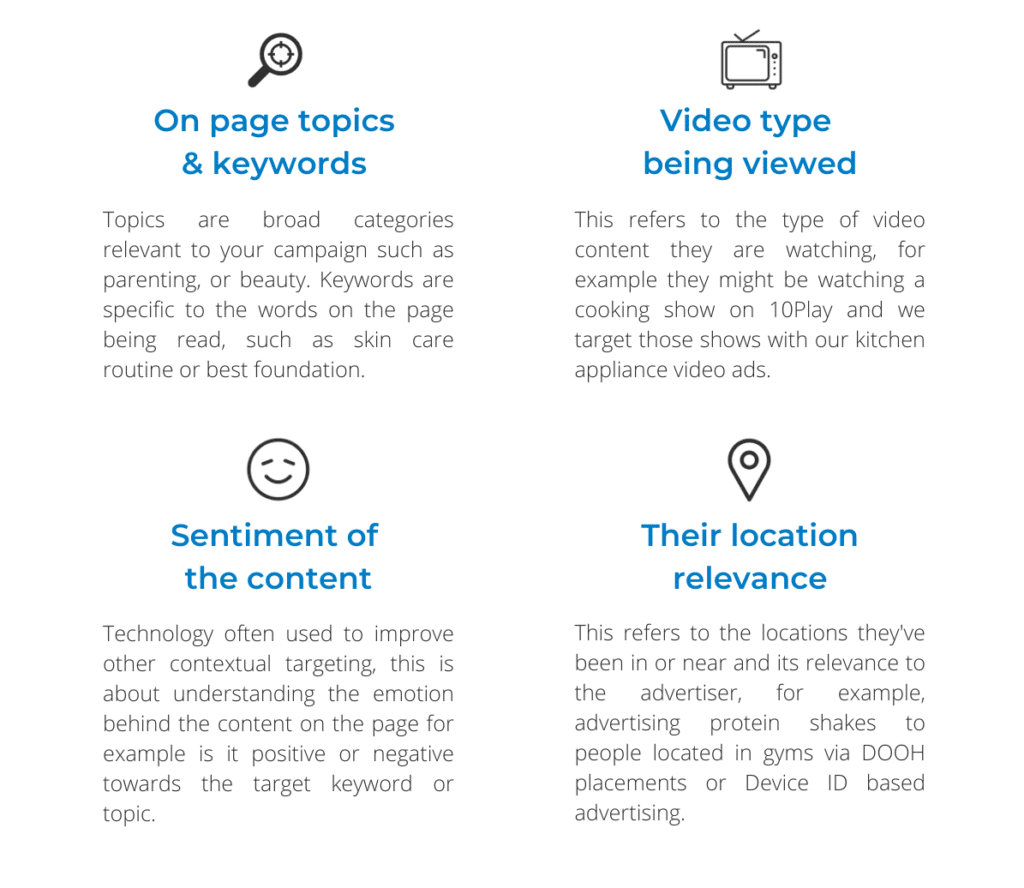From our discussions, most marketers understand the importance of building and utilising first party data for advanced prospecting strategies, but another front runner we see is the resurgence of contextual targeting.
Everyday more and more marketers are asking, what comes next after the cookie crumbles.
Digital marketers have been riding the wave of targeting users based on their actions and behaviours, but the shift to more stringent privacy standards means this targeting will become much more difficult, even impossible. Contextual targeting (if you’ve been living under a cookie for the past couple decades) is focused on the environment the user is in (e.g. website) and the type of content they are consuming. Based on this, we can make assumptions that the majority of users we’ll reach in this context would be a relevant prospect for us. By targeting based on the content the user is consuming, we aren’t subject to these privacy regulations, meaning it’s a great option to throw into the mix to broaden your prospecting strategies. Here are some examples:
Types of Contextual Targeting

An added advantage of this kind of advertising is that ads that are related to the content surrounding them are more likely to be remembered, and people are proven to be more receptive to them compared to ads that are unrelated to what they’re already viewing. Add to that aligning the ads with positive sentiment, and you’ve got yourself a winner.
But don’t just take our word for it… contextual targeting strategies have proven to be effective in driving results with a whopping 51% of consumers reported having a favourable perception of brands whose ad message relates to the content they are reading; and 74% of consumers are likely to remember an ad if the message relates to the content around it.
There are countless ways a contextual advertising strategy could work for you. Some specific examples we’ve seen it work for in are:
- A typically difficult target audience to hit – using B2B as an example, you might be trying to speak to people who work in a specific industry such as engineering or aviation. Safe to say not many platforms have check boxes for this type of targeting and you also might only want to talk to these people in a professional setting, so you might look at running campaigns with publications specific to the industry as a way of getting in front of them.
- A “niche” or taboo topic – you might be trying to sell a product or service that could apply to many people in a general demographic however it may be something we can’t easily choose when building a targeting strategy. A good example of this is medical or health related products, you’ll often find it hard to advertise across social media platforms due to advertising policies, and serving ads about someone’s health on their feed might not be the best user experience from a user’s point of view. So to counteract both of these, we see advertisers run ads on these platforms that have incredibly broad targeting, and the content in the ads about the brand and product/service are so generalised and almost “wishy-washy” to get around any advertising policies – but this often leads to a lot of wasted spend for the advertiser. A more relevant option would be to align your product or service with health related sites, because firstly, we can communicate valuable information about our products, and secondly, when the user is reading about their health they are signalling to us that they are more open to our type of content at this moment.
- Mindset – Following on from example two, it’s also about putting yourself in the shoes of the consumer and asking when they might be most receptive to taking in your message. For example, targeting a new mum with baby skin care products when they are reading articles about newborn parenting is much more relevant than if that user is scrolling their social feed to catch up on what their friends are up to. With suggestion one, we know, in real time that they are in a mindset that aligns with us.
So why aren’t more brands taking advantage of contextual targeting?
The largest barrier to entry we often see with our clients is the sheer amount of options and potential avenues to go down when you go beyond “the walled gardens” in digital advertising, it can feel overwhelming to even know where to start. That’s what your partner agency support and expertise is for; over the years we’ve executed contextual based campaigns across various industries and businesses that makes our approach to pulling together goals-based, comprehensive, and unique campaign plans stronger for our clients.
Reach out to the Reload team if you think Contextual targeting is relevant for your business and we can help put together a strategy.
Find out more about the Contextual Targeting by contacting a Reload Strategy Specialist today.





















